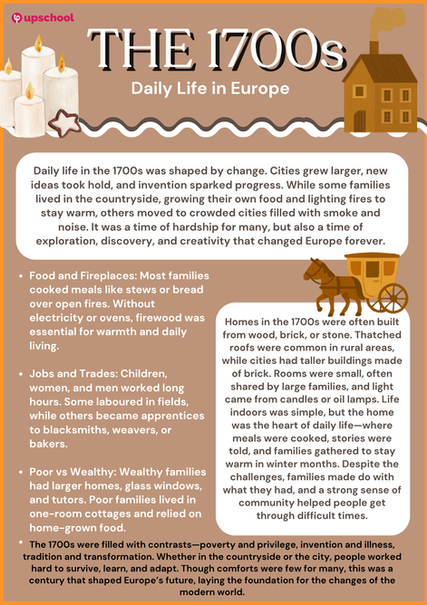The History of Language
Idioms Week 2 - To Steal Someone’s Thunder
Idiom of the Week! – To Steal Someone’s Thunder
This activity strengthens students’ speaking and listening skills. Use the video as a conversation starter. Ask open-ended questions like, “How would you feel if someone took credit for your idea?” or “Why do you think the audience loved the stolen thunder sound so much?” Guide students to listen actively to one another’s stories and express themselves clearly. This is also a great opportunity to model respectful group dialogue, empathy, and taking turns in discussion.
Focus: Speaking & Listening
Watch Gavin’s short video to discover where the saying “steal my thunder” really comes from. It might sound dramatic, but it all started with a real invention and a very frustrated playwright!
After the video, turn to a partner and talk about what you found interesting. Have you ever had your idea taken by someone else? How did it feel? What did you do? Be ready to share your thoughts with the class.
Vocabulary – Weekly Keywords
his task helps children explore new vocabulary in a meaningful context.
Begin by reading the ten words aloud together and discussing any that are unfamiliar. Encourage children to define each word in their own words to support ownership of learning and deepen understanding. Where possible, link each word back to the story of John Dennis to keep the context relevant. Sketching a visual connection to one of the words helps reinforce memory, especially for visual learners.Focus: Vocabulary Building
Here are your ten powerful words for the week:
steal, entertainment, spy, deceive, cancelled, disappointed, rage, embarrassed, reveal, and thunder.
Find out what each word means by looking it up or asking someone.
Write a short definition in your own words.
Use each word in a sentence that shows you understand it.
Choose one of the words and draw a little sketch to help you remember it.

Quote of the Week
This task encourages reflection and analysis. Facilitate a short class discussion, then allow individual or group writing. Emphasise linking ideas across texts and themes. Invite children to support their interpretations with examples, helping them learn how to build an argument and explore ideas deeply.
Focus: Critical Thinking
Read this quote with a friend:
“It is amazing what you can accomplish if you do not care who gets the credit.” – Harry S. Truman
Have a chat about what you think it means. Why do you think President Truman believed we can achieve more when we focus on the goal instead of the praise? How does this quote link to the story of John Dennis and the idea of stealing someone’s thunder? Why is it important to give others credit for their ideas?
Now, using the quote card template provided, find a new quote about honesty, fairness, or creativity from another famous person. Add their quote to your card, decorate it, and display it in your school halls or classroom.

Idiom Card – Where Did It Come From?
Children practise decoding figurative language and understanding idiom origins.
Read the story of John Dennis aloud together and highlight key moments, such as his invention, the cancellation of his play, and the moment he heard his thunder sound being used by someone else. Discuss the literal meaning (someone taking his actual thunder sound) and the figurative meaning (someone taking credit or attention).Focus: Reading for Meaning
Did you know this saying comes from a theatre in London over 300 years ago? A man named John Dennis created the sound of thunder using a sheet of metal for his play. But after his show was cancelled, he heard another play using his sound effect—without asking! Angry, he stood up and shouted, “You may have cancelled my play, but you will never steal my thunder!”
That’s how the idiom “steal someone’s thunder” began.

Comprehension History Card – Life Back Then
Students build contextual understanding of the idiom by exploring historical settings. Begin by reading the history card together, pausing to unpack unfamiliar words and ideas. Support students in making inferences—What might it have felt like to live without electricity? What sounds or smells would have filled the streets? Encourage comparisons between life in the 1700s and today, prompting thoughtful discussion.
Focus: Reading Comprehension
Let’s go back to the 1700s! Imagine walking through a noisy city street—what would you see, smell, and hear? Would there be horses clattering past, factory smoke rising, or street sellers calling out? What kinds of jobs did people do, and how did they live?
Read your history card to learn all about life in the 1700s. Then, answer the questions and imagine what your life might have been like. Would you be a blacksmith, a maid, a scientist, or an explorer?
Write a few sentences describing a day in your life in the 1700s. What would you wear? Where would you go? What would you do?
Write Your Answers
This activity encourages children to reflect on a historical scene and answer comprehension questions in full sentences. It promotes critical thinking, sentence construction, and historical understanding. The accompanying answer card provides structure and motivation, allowing students to work at their own pace in a calm, independent, and confidence-building environment.
Focus - Comprehension and Collaboration
Use this card to record your answers from the comprehension questions above.
Remember to try and write in full sentences and get as far as you can.
Get a Move on!!!

Spin the Wheel and Choose Your Idiom!
During this activity, allow the children to use the wheel to determine which era they’ll explore for their idiom of choice. The element of surprise adds excitement and a sense of adventure to their learning journey.
Encourage fun and laughter as the wheel spins — build the suspense, cheer together, and make it feel like a moment of celebration! At the same time, make sure the children feel a sense of ownership. Give them freedom to dive into their era in a way that feels right for them.
Each week, you'll have the chance to dive into a new idiom from a different moment in history — all revealed in the next part of this sequence.
But first… let’s leave it up to fate!
Spin the wheel and let random chance decide which era you’ll be exploring. Once your time period is revealed, head to the matching card in the next section of this lesson and discover an idiom worth unravelling.
Spin the wheel… and hold on tight!
Choose This Week's Idiom to Research
Each week, students independently select an idiom to research, exploring its origin, history, and meaning. This fosters critical thinking, creativity, and deep engagement with language. As they uncover the cultural stories behind each phrase, students build strong research skills and learn to manage their time and present their findings confidently. The activity promotes independence, curiosity, and cross-curricular learning, allowing children to take ownership of their education while developing a rich understanding of language and history.
Focus - Independent Research
Each week, we’re going to ask you to choose your very own idiom to investigate and explore. Etymology—the study of word origins—is a fascinating way to uncover the hidden stories behind the phrases we use every day. Some idioms date back hundreds of years, while others are more modern and mysterious.
Take a look at the menu of idioms. Each week, you’ll pick one to use as the foundation for your research.
Through these phrases, we can uncover so much about the history, culture, and way of life of humankind throughout the ages.
.

Choose an Idiom – Make Your Own Comic
This task encourages inquiry, summarising, and creativity.
Begin by discussing a few fun or commonly heard idioms as a class to spark curiosity. Provide a list of options or allow students to research their own idiom using books or trusted websites. Support those who need guidance with sentence starters (e.g., “I couldn’t believe it when...”) and offer a blank four-panel comic template to structure their ideas.
Focus: Independent Research and creative Arts
Now it’s your turn to become a comic creator!
Choose a new idiom—one that sounds funny, unusual, or really interesting—and find out where it comes from and what it actually means. Once you’ve got a good understanding of it, it’s time to bring it to life in a four-panel comic strip.
Show someone using the idiom in either a real-life or completely silly situation. Each panel should include a speech bubble to help tell the story clearly.
.png)
Silent Shout-Out Board
Students will create a poster titled “Honesty Is…” to express what honesty means to them through words and visuals. This task encourages creativity, personal reflection, and student voice. Completed posters will be presented to the principal, with the chance for student ideas to be included in the school handbook.
Focus: Creative Communication and teamwork
This week, we’re setting up something special in our classroom—a Silent Shout-Out Board!
Here’s how it works:
If you notice someone doing something kind, clever, or helpful—write it down and pop it on the board! You can keep your name secret, or sign it if you want to.
You might say something like:
“I saw Layla helping someone pack away the paints—so kind!”
“Shout-out to Noah for sharing a great idea in science today.”
“Well done to Zara for staying focused on her writing all morning!”
We won’t always get the chance to say these things out loud—but this board is our quiet way of saying “I see you”, “thank you”, and “you made a difference.”
Let’s fill it with positivity and make someone smile every day!

Teach a Lesson – You’re the Teacher!
This task encourages ownership of knowledge and confidence in presentation. Support students in structuring their lesson using a simple outline. Encourage peer teaching or buddy class presentations. Teaching promotes deeper understanding, communication, and empathy—powerful life and learning skills.
Focus: Leadership & Teaching Skills
Now it’s your turn to teach! Create a fun mini-lesson to explain “stealing someone’s thunder” to a younger child or a classmate. You might like to use a drawing, a skit, a puppet, or even a game to bring your explanation to life.
Be sure to include:
What the idiom means?
Where it came from?
An example of it being used
Teaching someone else is one of the best ways to understand something deeply—so have fun, get creative, and let your lesson shine!

Art Therapy – Life in 1700s London
This activity invites children to step into the bustling streets of 1700s London through observation, discussion, and creative expression. They'll examine a detailed historical scene, explore its key features, and begin to imagine what daily life may have felt like for the people who lived during that time.
Using a black-and-white version of the image, children will colour it in mindfully – ideally in a peaceful space with soft music playing. This is more than just an art activity; it’s an opportunity to pause, reflect, and connect with the past. As they colour, children are encouraged to build empathy, spark curiosity, and enjoy a quiet moment of historical exploration.
Focus: Quiet Reflection
Take a moment to explore this image showing everyday life in London during the 1700s.
What details stand out to you? What do you think the people in the scene are doing? Why might life have looked like this back then?
Once you've had a good look, use the provided template to create your own version. Find a quiet, calm place – perhaps in the library – and settle in with some gentle music if you like. Let this be a time for peaceful reflection.
Remember, this isn’t just about colouring in. It’s a chance to slow down, to breathe, and to let your imagination transport you to another time. As you bring the scene to life with colour, pay attention to how you feel – relaxed, curious, or even inspired. Let your mind wander freely, just as it would have through the cobbled streets of old London.

.png)





